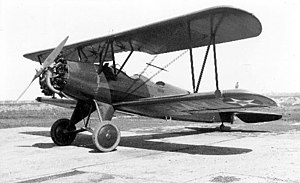Loading AI tools
From Wikipedia, the free encyclopedia
The Consolidated Model 2 was a training airplane used by the United States Army Air Corps, under the designation PT-3 and the United States Navy under the designation NY-1.
| PT-3 | |
|---|---|
 Consolidated PT-3 | |
| General information | |
| Type | Trainer |
| Manufacturer | Consolidated Aircraft Company |
| Primary user | United States Army Air Corps |
| Number built | 250 |
| History | |
| Manufactured | September 1927 |
| Introduction date | 1927 |
| Variants | Consolidated NY, Consolidated O-17 |

Seeing the success of the Navy's NY-1 modification of a PT-1 airframe, the USAAC came to the conclusion that a radial engine was indeed ideal for a trainer. It was reliable and offered a good power-to-weight ratio. Therefore, one PT-1 airframe was completed as XPT-2 with a 220 hp (164 kW) Wright J-5 Whirlwind radial engine.[1]
The XPT-3 was almost identical to the XPT-2 except for the tail, revised wing panels and different shape. 130 production PT-3 aircraft were ordered in September 1927,[1] with one being completed as the XO-17. These were followed by 120 PT-3A aircraft with minor changes. The XPT-3 became the XPT-5 when fitted with the Curtiss Challenger R-600 two-row six-cylinder radial engine, but was soon converted to PT-3 standard.[2]
The PT-3 aircraft were superseded by the Boeing PT-13 Stearman starting in 1937, but a number were still operational with the Spartan Flying School in Tulsa Oklahoma into the middle of World War II.[1]
Data from "United States Military Aircraft Since 1908" by Gordon Swanborough & Peter M. Bowers (Putnam Newy York, ISBN 0-370-00094-3) 1977, 675 pp.
General characteristics
Performance
Seamless Wikipedia browsing. On steroids.
Every time you click a link to Wikipedia, Wiktionary or Wikiquote in your browser's search results, it will show the modern Wikiwand interface.
Wikiwand extension is a five stars, simple, with minimum permission required to keep your browsing private, safe and transparent.